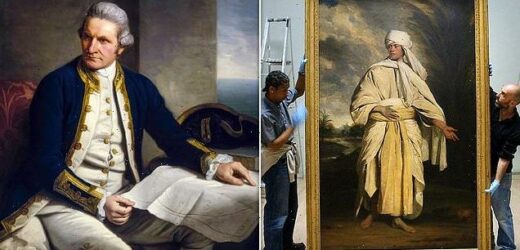The £50m masterpiece that proves 18th-century Britain wasn’t as racist as its critics paint it: Gallery will discover whether it can keep Joshua Reynolds’ ‘Portrait of Omai’ – the first great British painting of a person of colour -TOMORROW
- Joshua Reynolds’ 1776 masterpiece ‘Portrait of Omai’ depicts a Polynesian noble
- The National Portrait Gallery will learn tomorrow whether it can keep painting
He was little more than a boy when Captain Cook landed in Tahiti in 1769 but Omai — a Polynesian tribesman who was to become the toast of 18th-century London — already had a taste for adventure.
Barely out of his teens, Omai had seen his father killed by rival warriors, been taken prisoner himself and had escaped, narrowly cheating death.
An unexpected twist of fate brought him to London in 1774, where he was feted as a celebrity: he was introduced to King George III, he dined with the great naturalist Sir Joseph Banks and was painted by Sir Joshua Reynolds.
‘Portrait of Omai’, Reynolds’s exquisite depiction of the young daredevil, has long been considered a masterpiece of Georgian art.
It hangs — for now — in the National Portrait Gallery, which has been fighting a desperate battle to keep it since it was put up for sale last year.
‘Portrait of Omai’, Reynolds’s exquisite depiction of the young tribesman, has long been considered a masterpiece of Georgian art
Whether this campaign has succeeded, we will discover when the time limit on a government-imposed export ban runs out — tomorrow.
The portrait, owned by a company controlled by Irish billionaire John Magnier, will be sold on the open market if the gallery and others cannot come up with the money to acquire it. The 7ft-high Portrait Of Omai has been valued at a jaw-dropping £50 million, putting it on a par with Titian’s Diana And Actaeon, the most expensive work ever bought by a British gallery.
The Government agreed to impose the export ban last year after an appeal by art historians and academics, giving arts organisations a chance to save ‘one of the greatest British portraits’ for the nation.
The portrait matters not just because it is the first great British painting of a person of colour, but because its very existence casts a far more nuanced light on London society at the height of the supposedly irredeemably racist British Empire. Some on board Cook’s ship might have been wondering how a ‘native’ would respond to European society, but once he arrived here, the tables were turned.
Omai’s charm and good humour captivated high society, dispelling any misconceptions about ‘non-Europeans’. Far from being racist, London society embraced him.
Some details of Omai’s life are sketchy, but we know he was a landowner’s son, born on Ra’iatea, one of the Society Islands in the South Pacific, an archipelago that includes the breathtakingly beautiful, coral-fringed Tahiti.
Omai met Captain Cook when the explorer’s first voyage of discovery landed there in 1769, with naturalist Sir Joseph Banks among its number.
Cook invited the young Polynesian to join his second expedition in 1773. Omai took a place on board HMS Adventure, the sister ship to Cook’s HMS Resolution. Cook’s ships had already visited Antarctica and were heading back there from Tahiti when they were separated by a storm off the coast of New Zealand.
Omai met Captain Cook (pictured) when the explorer’s first voyage of discovery landed there in 1769, with naturalist Sir Joseph Banks among its number
After waiting three weeks in Queen Charlotte Sound with no sign of the Adventure, Cook set off with the Resolution towards the sub-zero temperatures of the Southern Ocean.
The Adventure made it to Queen Charlotte Sound about a week after Cook sailed, but while it was stocking up on supplies some of its crew were killed in a dispute with local Maoris and its skipper decided to return to Britain.
Omai’s arrival in London caused a sensation. He must have learned some rudimentary English along the way, for when introduced to George III, he baffled many by asking: ‘How do you do, King Tosh?’
His charm and distinctive bow delighted everyone he encountered, so much so that his story inspired the dramatist John O’Keefe to write Omai — A Trip ’Round The World, which played at the Theatre Royal in Covent Garden a few years later.
With Cook still at sea, Sir Joseph Banks (who would also be painted by Reynolds), took Omai under his wing. The Polynesian visited the Royal Society and dined with Samuel Johnson. Banks even took him to Yorkshire, to visit a friend of Cook’s, Captain Phipps.
He stayed for around a month and there too, became an object of fascination.
‘He arrived in Scarborough in a coach and four and went swimming. Being Polynesian, of course he was a marvellous swimmer and went out into the water with a young boy on his shoulders, showing off his tattoos,’ said Dr Sophie Forgan, chair of trustees at the Captain Cook Memorial Museum in Whitby, who was one of the signatories to the letter asking the Government to save the portrait. ‘When a shopkeeper in Whitby offered Ma’i, as we refer to him [his original Polynesian name], a piece of snuff, he was confused. He said his nose wasn’t hungry. He was taken shooting and shot some chickens as well as the pheasants.
‘So there are wonderful stories about him — but what’s important is that he was such an extraordinary young man, prepared to sail off into the unknown. And what is at stake here is a great portrait, by a great artist.’
Reynolds, first president of the Royal Academy, exhibited the portrait of Omai in 1776, to great acclaim. The painting was not commissioned, so it stayed in his studio until his death in 1792.
It was acquired by the Howard family and displayed in the Reynolds Room at Castle Howard for 200 years. It was only seen in public again at the Royal Academy in 1954.
In November 1984 it was offered to the Tate Gallery for £5.5 million, but the gallery rejected the offer. It sold at auction in 2001 for £10.3 million (including fees) to a Swiss company controlled by the Irish billionaire Magnier.
The stud owner has since made several unsuccessful attempts to move the painting to Ireland, but each one was blocked by the British government.
In the portrait, Reynolds presents Omai barefoot, wrapped in ochre robes and wearing a turban, an outfit more reminiscent of Turkey or the Middle East than Polynesia. This neo-classical garb and studied pose render Omai ‘both exotic and familiar’, as art dealer and historian, Philip Mould, who co-hosts (with Fiona Bruce) BBC’s Fake Or Fortune, tells the Mail.
As a piece of 18th-century British portraiture it’s extraordinarily important — as both a representation on a grand scale of a man of colour and because it is a transcendently good-quality work,’ Mould adds.
‘It is also — and this is so rare for Joshua Reynolds — in extraordinarily good condition.’
He adds that the estimate of £50 million it might fetch on the open market is about right.
The National Portrait Gallery — which is in the midst of a £35 million refurbishment — has been coy about its involvement in trying to save Omai, saying in a statement only that it is ‘supportive of the crucial efforts being made to give UK institutions the opportunity to acquire this uniquely important painting for the nation’.
The Art Newspaper has recently reported that the National Portrait Gallery may have struck a deal with the Getty Museum in California to buy jointly and share the painting — the Getty being its main competitor if the work goes on the market.
The Getty says it does ‘not comment on potential acquisitions’ and it is not easy to see how such an arrangement would work, given that the painting would have to travel to and fro across the Atlantic, but it may be the only hope.
The dream would be for a wealthy benefactor to gift the painting to the National Portrait Gallery. So far, the National Heritage Memorial Fund has pledged £10 million to try to save the work, the Art Fund has given £2.5 million, it’s biggest grant ever, in addition to 1,500 donations from individuals and foundations. In total, around half of what would be needed to buy the painting has been raised.
As a last resort, perhaps the Government could extend the export ban yet again: it is considering a request from the Gallery to put the deadline back to June.
Omai took the opportunity to return to Polynesia when Cook set out on his third, and final, voyage to the Pacific in 1776. He settled on the island of Huahine, in a European-style house with a vineyard and two Maori boys as servants.
Two years later when Captain Bligh visited Tahiti aboard the Bounty (later famous for its mutiny) he learned that Omai had died, probably in late 1779, aged only about 27.
His memory lives on in this extraordinary picture: it would be sad indeed to see such an icon of British culture leaving our shores.
Source: Read Full Article




